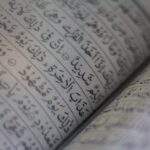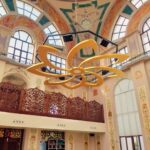The Cultural Significance of the Arabic Alphabet in Art
The Arabic alphabet is more than just a set of characters used for communication; it is a visual language that speaks volumes in the world of art. From intricate calligraphy to modern graphic design, the Arabic script has played a pivotal role in artistic expression across cultures. Join me on this journey as we explore the cultural significance of the Arabic alphabet in art. 🎨
Table of Contents
1. Introduction to the Arabic Alphabet in Art
2. The Historical Roots of Arabic Calligraphy
3. The Influence of Arabic Script in Modern Art
4. The Role of Arabic Typography in Graphic Design
5. Conclusion
6. FAQs
Introduction to the Arabic Alphabet in Art
The Arabic alphabet is not just a means of writing but an art form in itself. With its flowing lines and elegant curves, it has been used for centuries to adorn everything from religious texts to public architecture. The beauty of the script lies in its versatility, allowing artists to experiment with form and space, making it a powerful tool for artistic expression. 🖌️
The Historical Roots of Arabic Calligraphy
Arabic calligraphy has deep historical roots dating back to the 7th century. Originally used to transcribe the Quran, calligraphy became a revered art form in Islamic culture. Master calligraphers developed various styles, including Kufic and Naskh, each with its unique aesthetic and purpose. The intricate designs often adorned mosques, manuscripts, and palaces, reflecting the spiritual and cultural values of the time. 📜
The Influence of Arabic Script in Modern Art
In contemporary times, the Arabic script continues to inspire artists worldwide. Modern art movements have embraced the script’s artistic potential, blending traditional techniques with modern themes. Artists like Shirin Neshat and Hassan Massoudy have gained international acclaim for their work, which often explores themes of identity, politics, and culture through the lens of the Arabic alphabet. Their art not only highlights the beauty of the script but also its capacity to convey powerful messages. 🖼️
The Role of Arabic Typography in Graphic Design
Arabic typography has become an essential element in graphic design, especially in regions where Arabic is the primary language. Designers are continuously innovating, creating typefaces that are both functional and aesthetically pleasing. The fusion of traditional calligraphy with digital design techniques has opened new avenues for creativity, allowing brands to communicate their identity while respecting cultural heritage. Whether it’s in advertising, branding, or web design, Arabic typography is a testament to the script’s adaptability and timeless appeal. 💻
Conclusion
The Arabic alphabet is a profound cultural symbol that transcends its linguistic purpose to become a celebrated art form. Its historical significance and modern-day applications showcase the enduring power of the script in the world of art and design. As we continue to appreciate and explore the artistic potential of the Arabic alphabet, we honor a rich cultural legacy that has shaped artistic expression for centuries. 🌟
FAQs
Q: What are some popular styles of Arabic calligraphy?
A: Some popular styles include Kufic, Naskh, Thuluth, and Diwani, each with distinct features and uses.
Q: How has modern technology impacted the use of Arabic script in art?
A: Modern technology has enabled artists to experiment with new techniques, merging traditional calligraphy with digital art forms, expanding the script’s application in graphic design and multimedia.
Q: Can Arabic calligraphy be used in non-religious art?
A: Absolutely! While it has religious roots, Arabic calligraphy is widely used in secular art, exploring themes such as identity, social issues, and personal expression.
Q: Is it challenging to learn Arabic calligraphy?
A: Like any art form, learning Arabic calligraphy requires practice and patience. However, with dedication and guidance, anyone can appreciate and create beautiful calligraphic works.
Q: What role does Arabic script play in global art movements today?
A: The Arabic script plays a significant role in global art movements by providing a unique cultural perspective and aesthetic, enriching the diversity of artistic expression worldwide.





